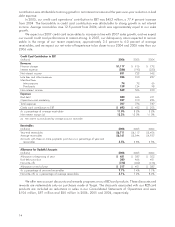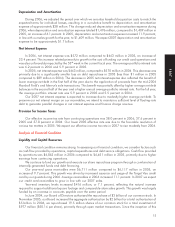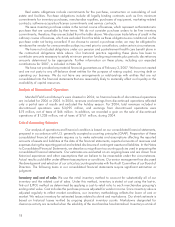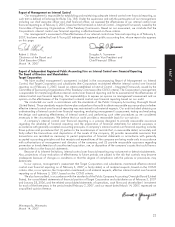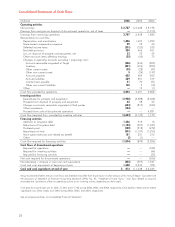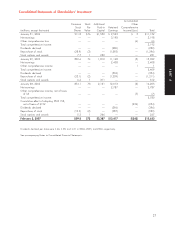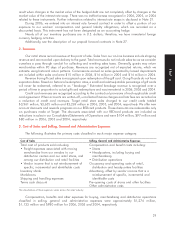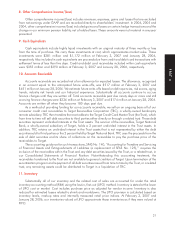Target 2006 Annual Report Download - page 41
Download and view the complete annual report
Please find page 41 of the 2006 Target annual report below. You can navigate through the pages in the report by either clicking on the pages listed below, or by using the keyword search tool below to find specific information within the annual report.
1APR200416064753
1APR200416063806
Report of Management on Internal Control
Our management is responsible for establishing and maintaining adequate internal control over financial reporting, as
such term is defined in Exchange Act Rules 13a-15(f). Under the supervision and with the participation of our management,
including our chief executive officer and chief financial officer, we assessed the effectiveness of our internal control over
financial reporting as of February 3, 2007, based on the framework in Internal Control – Integrated Framework, issued by the
Committee of Sponsoring Organizations of the Treadway Commission. Based on our assessment, we conclude that the
Corporation’s internal control over financial reporting is effective based on those criteria.
Our management’s assessment of the effectiveness of our internal control over financial reporting as of February 3,
2007, has been audited by Ernst & Young LLP, independent registered public accounting firm, whose report also appears
on this page.
Robert J. Ulrich Douglas A. Scovanner
Chairman of the Board and Executive Vice President and
Chief Executive Officer Chief Financial Officer
March 14, 2007
Report of Independent Registered Public Accounting Firm on Internal Control over Financial Reporting
The Board of Directors and Shareholders
Target Corporation
We have audited management’s assessment, included in the accompanying Report of Management on Internal
Control, that Target Corporation and subsidiaries (the Corporation) maintained effective internal control over financial
reporting as of February 3, 2007, based on criteria established in Internal Control – Integrated Framework, issued by the
Committee of Sponsoring Organizations of the Treadway Commission (the COSO criteria). The Corporation’s management
is responsible for maintaining effective internal control over financial reporting and for its assessment of the effectiveness of
internal control over financial reporting. Our responsibility is to express an opinion on management’s assessment and an
opinion on the effectiveness of the Corporation’s internal control over financial reporting based on our audit.
We conducted our audit in accordance with the standards of the Public Company Accounting Oversight Board
(United States). Those standards require that we plan and perform the audit to obtain reasonable assurance about whether
effective internal control over financial reporting was maintained in all material respects. Our audit included obtaining an
understanding of internal control over financial reporting, evaluating management’s assessment, testing and evaluating
the design and operating effectiveness of internal control, and performing such other procedures as we considered
necessary in the circumstances. We believe that our audit provides a reasonable basis for our opinion.
A company’s internal control over financial reporting is a process designed to provide reasonable assurance
regarding the reliability of financial reporting and the preparation of financial statements for external purposes in
accordance with generally accepted accounting principles. A company’s internal control over financial reporting includes
those policies and procedures that (1) pertain to the maintenance of records that, in reasonable detail, accurately and
fairly reflect the transactions and dispositions of the assets of the company, (2) provide reasonable assurance that
transactions are recorded as necessary to permit preparation of financial statements in accordance with generally
accepted accounting principles and that receipts and expenditures of the company are being made only in accordance
with authorizations of management and directors of the company, and (3) provide reasonable assurance regarding
prevention or timely detection of unauthorized acquisition, use, or disposition of the company’s assets that could have a
material effect on the financial statements.
Because of its inherent limitations, internal control over financial reporting may not prevent or detect misstatements.
Also, projections of any evaluation of effectiveness to future periods are subject to the risk that controls may become
inadequate because of changes in conditions or that the degree of compliance with the policies or procedures may
deteriorate.
In our opinion, management’s assessment that Target Corporation and subsidiaries maintained effective internal
control over financial reporting as of February 3, 2007, is fairly stated, in all material respects, based on the COSO
criteria. Also, in our opinion, the Corporation maintained, in all material respects, effective internal control over financial
reporting as of February 3, 2007, based on the COSO criteria.
We also have audited, in accordance with the standards of the Public Company Accounting Oversight Board (United
States), the consolidated statements of financial position of Target Corporation and subsidiaries as of February 3, 2007
and January 28, 2006, and the related consolidated statements of operations, cash flows and shareholders’ investment
for each of the three years in the period ended February 3, 2007, and our report dated March 14, 2007, expressed an
unqualified opinion thereon.
Minneapolis, Minnesota
March 14, 2007
23
PART II



